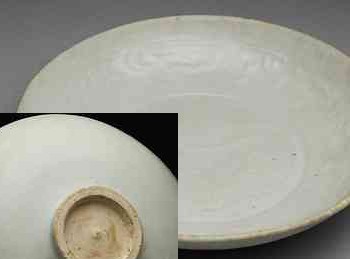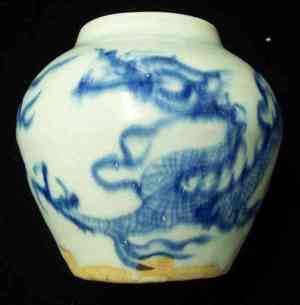Yuan Dynasty Ceramics
In the Yuan dynasty China was under Mongol rule. During that period the
production of porcelain and pottery continued and basically followed the
Song heritage. There were some developments and improvements in
manufacturing methods made, though, and the focus of production shifted
to blue and white porcelain.
Porcelain tiles
Although it is supposed that tiles did exist at least since the Tang dynasty, reliable proof for their existence is currently only available for the Yuan dynasty. Decorated Yuan porcelain tiles (Yuan dynasty: 1206-1368) had
various shapes and were embedded in the wood of furniture as decoration.
Shufu porcelain (Shufu ware)
Shufu wares are a type of porcelain specifically made at the Hutian kiln
during the Yuan dynasty. This type of porcelain has an appearance
similar to "qingbai" or white porcelain, but has an off-white color with
a very opaque glaze. The glaze of Shufu porcelain is completely non-reflective. This is sometimes described as a "candle wax" appearance.
Together with an impressed porcelain decoration that is protruding from
the base material, these features allow for easy recognition of Shufu
ware.
|
Shufu plate (Yuan)  |
The name itself comes for the two characters for Shufu (樞府),
which can be found on some of the porcelain items. There do exist items with different characters, some have only one character or no writing at all. |
Porcelain items carrying the Shufu characters are considered imperial porcelain. The majority of Shufu items are generally small items for daily use, like plates, bowls, etc. Decorative items like vases, jars, etc. are less frequent.
Underglaze blue porcelain decorations
During the Zhizheng reign (1341–1368), towards the end of the dynasty (1206-1368)
underglaze blue painted decorations were further developed at Jingdezhen. But, at the same time the development of underglaze red
decorations occurred, which met technical difficulties and only limited quantities of
the latter were made.
Note:
Polychrome decorations existed already earlier, but painted decorations were few and mostly limited to the colors green and red. Opinions of the actual beginnings of underglaze
blue decorations differ as archaeological and other proof is still
insufficient, but the earliest underglaze blue decorations found to date are from the Tang dynasty and had only simple decorations. There are extremely few of them extant.
Export of blue and white porcelain
Quantities of these Yuan dynasty blue and white porcelain wares
were exported to more than a dozen places in SE Asia, South Asia, the
Middle East and possibly East Africa.
The blue and white porcelain exported to SE Asia consisted mainly of smaller items, like small jarlets, etc., while those going to the Middle East were mainly large items. Few remain in China. They were mainly made for export. The large ones can be seen mainly in the museums in Turkey and Persia.
|
Yuan dynasty jarlet in blue and white porcelain  |
Today, the blue and white porcelain of this era is highly priced. |
While in the Song dynasty celadon wares were probably the most favored ceramics, which were also heavily exported to the Middle East, the Mongol rulers took a liking to the still uncommon blue and white ceramics. The development of underglaze blue decorations can be considered as one of the main causes for a major decline of the older celadon producing kilns, overall, during the Yuan dynasty. Jingdezhen with its blue and white porcelain became more important.
Longquan Celadon
Only the kilns producing Longquan celadons in the south were an exception. While production of other celadon
kilns generally declined, the production of Longquan kiln(s) grew,
paradoxically, due to huge export orders.
Green and Red Decorations (on-glaze)
Worth mentioning is also that painted (pictorial) on-glaze decorations
in the colors red and green also reached new levels during this period.
They already had the quality of the Zhaozhou wares (aka Swatow wares)
that were exported to Japan throughout the later Ming dynasty, until the 17th
century.
Return from Yuan Dynasty to Antique Porcelain home page
Song dynasty ceramics
